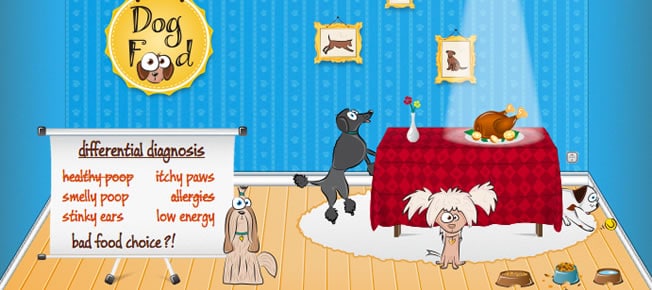Your Dog, the Pet Food Industry, and BARF
Does your dog suffer from itchy paws, stinky ears, and low energy? Does he constantly seem to drop large, smelly stools? These may actually be symptoms of a poor diet.
Our researchers at Pet365 took a long look at the pet food industry when putting together the dog food information graphic, examining the ingredients in packaged dog food and comparing them to a natural diet. In addition, we checked pricing across the board in order to find the best values. Even branding trends came under consideration.
Natural vs. Packaged Nutrition
A wild dog would eat a diet that varied from day to day, but would ultimately consist of about 10 percent protein, 2 percent fat, and 76.5 percent moisture. However, a careful examination of pet foods on the market revealed that no packaged food matched these proportions.
Wet food comes closest to matching a natural diet. Unfortunately, even the most expensive wet foods were still lacking, with almost twice the healthy level of fat and barely half the requisite amount of protein. Middling-priced brands contained somewhat more protein with an eight percent concentration but also contained even more fat, added ash, and excess moisture. The cheapest brands contained a little less protein, fat, and ash than the moderately priced foods, with an equivalent concentration of moisture.
Dry foods also do not compare favorably to a natural diet. The cheapest foods available featured an impressive twenty-one percent concentration of protein, but that came packaged with an eight percent concentration of fat as well as an eight-and-a-half percent concentration of ash. Medium-priced foods once again had a little more protein at the expense of an increased fat content. While the most expensive brands were ash-free, they still contained far more fat than the natural diet.
Global Scale
Pet food is a huge industry, raking in 19.8 billion US dollars in 2011 alone. Sales are dominated by Mars and Nestle, who each own multiple labels of pet foods ranging from Beneful to Pedigree. Trailing far behind both Mars and Nestle in sales are Colgate-Palmolive and Procter & Gamble. This masking of brand names makes discerning the origin of your pet’s food rather difficult. It also means that even though the variety of labels available gives consumers the illusion of choice, most packaged foods are largely the same since they were manufactured by one of only a few major companies.
BARF Diet
One way to help ensure your pet gets the best possible nutrition is to avoid feeding packaged pet foods alone, electing instead to supplement your dog’s diet with bones and raw food – or BARF. This diet is made of real food such as raw bones, organ and muscle meat, yoghurt, fruit, and supplements. When putting together the dog food information graphic we were really careful to include as much detail as possible on this, without wanting to promote it too much (we’re BARF feeders).
Raw dog food has both advantages and disadvantages. Firstly, a raw diet can vastly improve canine health, leading to healthier skin, shinier fur, and cleaner teeth. Energy levels can also rise, and you may discover that your pet is voiding less. However, caution should be taken when switching your pet to BARF. If it is not portioned correctly or is given over too long a period, this diet can become unbalanced and do more damage than good. Dogs unused to chewing whole bones may choke or break their teeth gnawing on them. Sharp bones can also cause internal punctures. Lastly, raw meat is full of bacteria which can be a health hazard to both humans and dogs.
Foods to Avoid
Regardless of what you decide to feed your dog, there are some foods that should never be a part of a canine diet. These foods range from poisons to simple irritants and include chocolate, alcohol, and mushrooms.
Making an informed decision on your pet’s behalf can be a challenge. Not all pet foods are created equal, and your budget can easily influence the quality of food that is available to you and your dog. Using raw foods closer to what a dog would find for itself in nature can alleviate the problems caused by the lack of nutrition in packaged foods but also comes with its own risks. Be sure to consult with your vet before drastically altering your dog’s diet.



